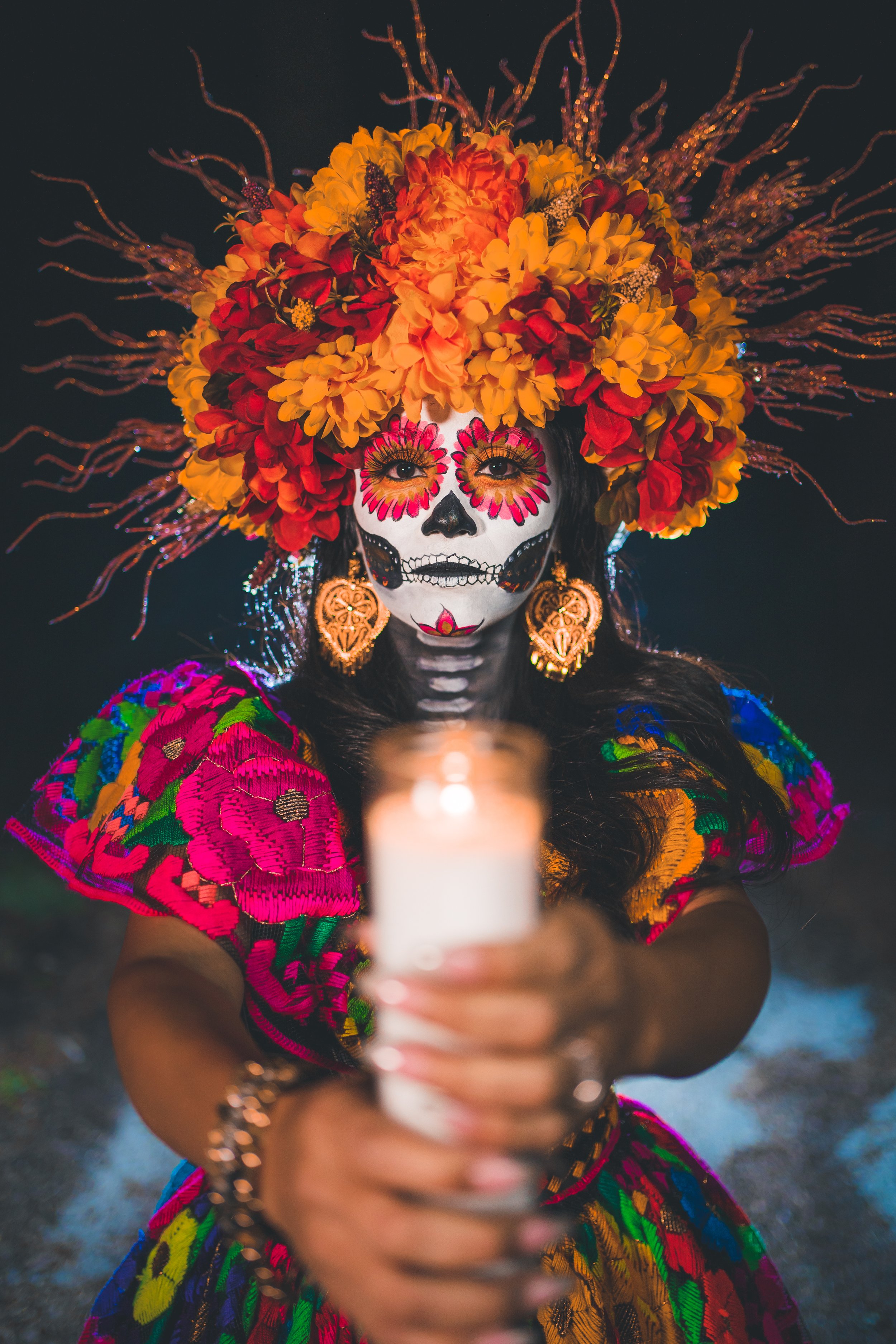Día de los Muertos is a traditional Mexican holiday that varies in length of celebration but is customarily celebrated on November 1 and 2. Depending on the location, some celebrations may last a whole week while others can last the entire month of November. The symbolism behind Día de los Muertos is becoming more widely known. This traditional holiday is a day of celebration to honor the lives of our loved ones. All throughout Mexico, and now around many places in the US, Día de los Muertos is a time for celebration with friends and family, a time to visit and elaborately decorate gravesites, create an altar in remembrance by placing flowers, commemorations, and offerings, and expressing oneself as a Catrina.
Anamaria Rocha, Executive Director, Mercado on Fifth dressed as a Catrina.
La Calavera Catrina, originally known as “La Calavera Garbancera,” was created by cartoonist, José Guadalupe Posada as an illustration of Posada’s political jab at dictator Porfirio Diaz who around 1910, made attempts to adopt higher class European materialisms and cultures at a time when many suffered in poverty. Her name, La Calavera Garbancera poked fun at chickpea sellers (garbanceros) commonly seen throughout the Mexican state of Guanajuato (where Posada lived for a short time) who had adopted European influences and as a result, began to reject and deny their indigenous roots. Posada is quoted as saying, “Death is democratic… Since after all, blond, dark, rich or poor, we all end up being skulls,” his words are believed to imply that beneath our social classes, we are the same; reminding people that death does not discriminate.
In 1947, the artist, Diego Rivera, reproduced La Calavera Garbancera in his famous mural “Dream of a Sunday Afternoon in the Central Alameda.” His painting included notable characters throughout 400 years of Mexican history. La Calavera Garbancera is at the center bearing a smile and is elegantly dressed. Her right hand is holding the hand of Rivera who is depicted as a young man; behind Rivera, is Frida Khalo, Rivera’s former mentee, comrade, lover, and wife. La Calavera Catrina’s left hand is holding the arm of her creator, José Guadalupe Posada, who is protectively cupping her hand as he glares at dictator Porfirio Diaz to the right of him, paying homage to her origins.
Many believe La Calavera Garbancera was inspired by the Aztec goddess of death, Mictecacihuatl, thereby connecting Posada’s disappointment with the Mexican people’s rejection of their indigenous roots with the context of his underlying message, however, it was during Rivera’s painting that La Calavera Garbancera was renamed “La Calavera Catrina.” Since then, the name has been shortened to La Catrina, as we know her today. La Catrina has become an iconic symbol for Día de los Muertos. The unique style of makeup represents the beauty of accepting death by bringing to the surface the representations of the similarities at our core. The celebratory traditions have widely spread into Mexican communities throughout the US, where many have begun to incorporate Día de los Muertos celebrations in their hometowns.
Jazmin Newton, Attorney, Newton Law, PLC (Left) and Anamaria Rocha, Executive Director, Mercado on Fifth (Right), dressed as catrinas.
“As José Guadalupe Posada intended to point out, it is important to embrace our culture and traditions and stay true to our roots. I work hard to authentically incorporate Mexican traditions into my family’s lives by learning more about them so that my children can pass those same traditions on to their children in the future” said Anamaria Rocha, Executive Director of Mercado on Fifth. “The first time I dressed up as a Catrina was about 10 years ago, I spent a lot of time meticulously planning every detail. Now I allow myself plenty of time so that my creativity can flow because I like to add a lot of intricate details to my Catrina interpretation,” Rocha said. “It gives me an opportunity to illustrate how beautiful a skeleton can be."
Día de los Muertos, like many traditions, has a personal meaning to everyone who celebrates, “For me, Día de los Muertos is an opportunity to reminisce the smallest details about my loved ones. We get busy in our day-to-day lives and because of that, I don't always think about things like their favorite drink, pastimes, candy, or snacks but putting up an altar gives me a reason to make the time and that leads to other memories that I hadn’t thought of in a while and it brings me comfort because I feel more connected to them. It’s like I’ve refreshed my memory and the memories of them are more vivid in my mind. It is very uplifting.”
Personal Día de los Muertos altar of Anamaria Rocha, Executive Director, Mercado on Fifth, in her home.




